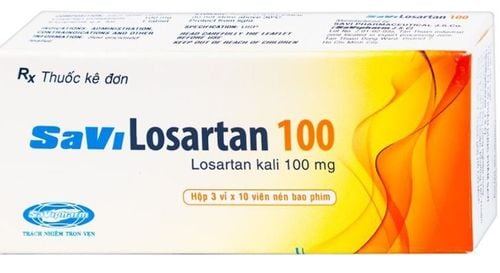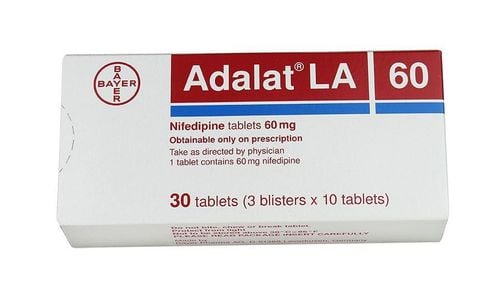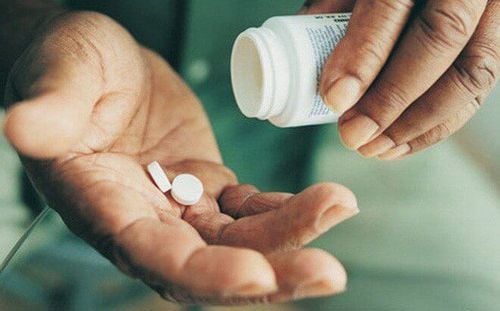This is an automatically translated article.
Lowlip medicine 40 mg contains the main ingredient is Telmisartan and other excipients in a sufficient amount. Lowlip 40 mg is used to treat mild to moderate hypertension.
1. What is Lowlip? The effect of the drug Lowlip
1.1. Pharmacodynamics of Lowlip 40mg Telmisartan blocks the vasoconstrictor and aldosterone-secreting effects of Angiotensin II by selectively blocking angiotensin II from binding to the AT1 receptor found in many tissues such as vascular smooth muscle or the adrenal gland. kidney. Therefore, the action of the active substance Telmisartan is independent of the pathway of Angiotensin II synthesis.
1.2. Pharmacokinetics of Lowlip 40mg After taking Lowlip 40mg, the peak concentration (Cmax) of the active substance Telmisartan is reached after 0.5 - 1 hour. Food slightly decreased the bioavailability of telmisartan, specifically reducing the area under the curve (AUC) by approximately 6% when a 40 mg tablet was taken and about 20% when a therapeutic dose of 160 mg was administered. The absolute bioavailability of telmisartan is dose dependent. When using Lowlip 40mg, the bioavailability of the active ingredient Telmisartan is 42% and 58%, respectively. The pharmacokinetics of Lowlip 40 mg orally is not linear in the dose range from 20 to 160 mg, the rate of increase in concentration (Cmax and AUC) is lower than that of dose increase. Telmisartan is degraded in a quadratic manner with a terminal half-life of approximately 24 hours. The trough plasma concentration of telmisartan when administered once daily is approximately 10-25% of the peak concentration. The accumulation coefficient of telmisartan in plasma ranges from 1.5 to 2.0 following repeated once-daily dosing. Lowlip 40 mg is indicated for the treatment of mild to moderate hypertension.
2. How to use and dose Lowlip
2.1. How to take Lowlip 40mg Take Lowlip 40mg orally.
2.2. Dosage of the drug Lowlip 40mg Treatment dose depends on each patient. The usual starting dose of telmisartan is 40 mg orally once daily. In some cases, there was a therapeutic effect with a daily dose of 20 mg. Regarding the ability to respond to blood pressure is dose dependent in the dose range from 20 to 80 mg. In most cases, Lowlip 40mg has a clear blood pressure lowering effect in about 2 weeks and usually reaches its maximum effect after 4 weeks. If a therapeutic dose of 80 mg Telmisartan is required to obtain a stronger antihypertensive effect, it can be used in combination with diuretics. Patients with mild to moderate hepatic impairment should not take doses exceeding 40 mg per day. Use in children: The safety and effectiveness of Lowlip 40mg in children have not been established. Note: The above therapeutic dose is for reference only. The specific treatment dose depends on the condition and the progression of the disease for each specific person. To get the right dose of treatment, you need to follow the instructions of your treating doctor or medical professional.
Cases of Overdose: The most common manifestations of overdosage with Telmisartan are hypotension, dizziness and tachycardia, possibly also bradycardia caused by parasympathetic stimulation. If symptomatic hypotension occurs, supportive therapeutic intervention is required. Telmisartan cannot be removed by dialysis. Missed dose: If you miss a dose, take it as soon as possible. However, if it is almost time for the missed dose, skip the missed dose and take your next dose at the scheduled time. Note that you should never take twice the prescribed dose.
3. Undesirable effects of the drug Lowlip
Some unwanted effects may be encountered when using Lowlip:
Urinary system infections, upper respiratory tract infections; Psychiatric disorders: feelings of anxiety, restlessness; Eye disorders, vision disorders; Ear and ear labyrinth disorders; Dizzy; Gastrointestinal disorders; Digestive disorders: abdominal pain, diarrhea, dry mouth, indigestion, flatulence; Skin and subcutaneous tissue disorders; Eczema, increased sweating; Disorders of bone formation, connective tissue, musculoskeletal system; Joint pain, back pain, leg cramps, leg pain, muscle pain, tendinitis-like symptoms; Chest pain, flu-like symptoms. As with other angiotensin II receptor antagonists, isolated cases of edema, urticaria and other associated symptoms have been reported.
Some rare adverse effects in clinical, such as:
Decrease in hemoglobin; Increased uric acid was more common with telmisartan than with placebo. Increases in creatinine and liver enzymes were also observed with telmisartan, but these biochemical changes were comparable to or lower than those observed with placebo.
4. Lowlip drug interactions
Currently, there are enough data to evaluate the safety and efficacy of Lowlip with concomitant use of ACE inhibitors or beta-adrenergic blocking agents.
Lowlip may increase the blood pressure lowering effect of this medicine.
Digoxin: Concomitant use of Lowlip drug increases the concentration of digoxin in the serum, so blood levels of digoxin must be monitored when starting treatment, adjusting and stopping Lowlip drug to avoid the possibility of digoxin overdose. .
Diuretics: Increases the antihypertensive effect of Lowlip.
Warfarin: Concomitant administration of Lowlip for 10 days resulted in a slight decrease in blood concentrations of warfarin but no change in INR.
Potassium-sparing diuretics: The daily regimen of adding potassium-containing preparations or taking with other drugs that cause hyperkalemia may increase the hypokalaemic effect of Lowlip.
5. Some notes when using Lowlip
Before using Lowlip 40mg, you need to carefully read the instructions for use and refer to the information below.
5.1. Contraindications of Lowlip drug Lowlip drug 40mg is contraindicated in the following cases:
Contraindicated for people with hypersensitivity to any ingredient of the drug. 5.2. Precautions when using Lowlip drug Telmisartan can be used for a long time, as long as the creatinine clearance rate is > 30 ml/min. People with loss of intravascular fluid should be treated to correct the condition, or should start using Lowlip under close supervision. Patients with biliary tract obstruction or hepatic insufficiency should also initiate treatment under close supervision. The dialysis operator may experience orthostatic hypotension, which requires close monitoring of blood pressure in these patients. Ability to drive and operate machines: Because Lowlip can cause headaches and dizziness, when using the drug, you should not drive in traffic and operate machinery after using the drug. Pregnancy: Lowlip has a direct effect on the renin-angiotensin system and can cause illness or death to the fetus and newborn when used for pregnant women. When you find out you are pregnant, you need to stop using telmisartan-containing preparations as soon as possible. General precautions during lactation: Lowlip can be passed on to a baby through breast milk. It is best not to or limit the use of Lowlip during breastfeeding. With the sharing of Lowlip drug, hope to bring you a lot of information on how to use the drug to ensure safety and effectiveness for the treatment process.
Please dial HOTLINE for more information or register for an appointment HERE. Download MyVinmec app to make appointments faster and to manage your bookings easily.













